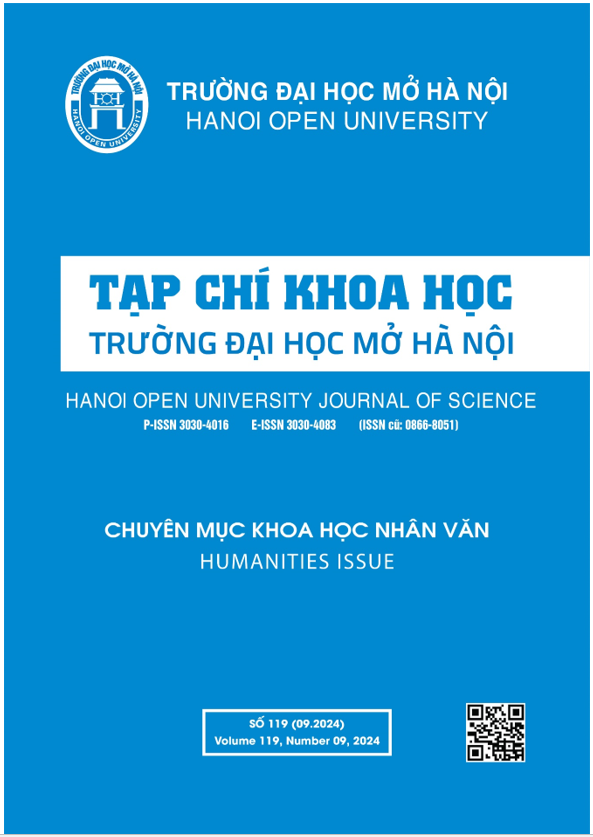NON-MAJOR ENGLISH STUDENTS’ ORAL COMMUNICATION STRATEGIES: A CASE STUDY AT A UNIVERSITY IN HANOI
DOI:
https://doi.org/10.59266/houjs.2024.461Từ khóa:
Students’ English intermediate level, oral communication strategies, English non-majorsTóm tắt
To gain a better understanding of language learning processes, specifically oral strategies utilized in communicative activities, this research intends to investigate the spoken communication skills of University of Economics – Technology for Industries (UNETI) students who are not majoring in English. English non-majors oral communicative capability at UNETI is not what one would expect after completing a university degree. However, research on communication tactics is uncommon in Vietnam since most earlier research on the subject seems to concentrate primarily on methodological or linguistic aspects affecting Vietnamese students' communicative competencies. Therefore, this research presents a study that generalizes communication methods used by intermediate-level English-speaking UNETI non-majors in English. It was a quantitative and qualitative investigation in which a communication strategy taxonomy suggested by Malasit, Y. and Sarobol, N. (2013) was used to analyze and identify students’ use of communication strategies in their recorded speaking performance. Data from students' interviews and informal recordings will be used to inform suggestions for teaching and learning English for communicative competence at UNETI.
Tài liệu tham khảo
[1]. Bui, T. T. Q., and Intaraprasert, C. (2012). Gender, High School Background and Use of Strategies by English Majors in Vietnam for Coping with Communication Breakdowns. International Journal of Scientific and Research Publications. Retrieved June 25, 2012 from: http://www.ijsrp.org/ researchpaper-1212/ijsrpp1289.pdf
[2]. Cenoz, J. (1998). Pauses and communication strategies in second language speech, US Department of Education, University of the Basque Country, Report-Research.
[3]. Corder, S. P. (1983). Strategies of communication. In C. Færch and G. Kasper (Eds.), Strategies in interlanguage communication (pp. 15- 19). London and New York: Longman.
[4]. Dobao,A. M. F., (2001). Communication strategies in the interlanguage of Galician students of English: The influence of learner- and task-related factors. Atlantis. 23(1): 41-62.
[5]. Decision No. 36/2004/QĐ-BGD&ĐT. (2003). Minister of Education and Training’s decision on curriculum for university students majoring in foreign languages. Hanoi: Vietnamese Government.
[6]. Decision Number 1400/QĐ-TTg. (2008). Government’s decision on Foreign languages teaching and learning for Vietnamese citizens 2008- 2020 program. Hanoi: Vietnamese Government.
[7]. Đỗ, H. T. (2006, October). The role of English in Vietnam’s foreign language policy: A brief history. Paper presented at the 19th Annual EA Education Conference 2006, Perth, Australia. Retrieved January 15, 2012 from: http://www.englishaustralia.com.au/ea_conference2006/proceedings/pdf/
[8] Faucette, P. (2001). A Pedagogical Perspective on Communication Strategies: Benefits of Training and an Analysis of English Language Teaching Materials. Second Language Studies 19.2: pp. 1-40.
[9]. Kellerman, Eric, and Bialystok, E (1997). On Psychological Plausibility in the Study of Communication Strategies. Communication Strategies. Psycholinguistic and Sociolinguistic Perspectives. Ed. Gabriele Kasper and Eric Kellerman. London: Longman. 31-48.
[10]. Luján-Ortega, Violante (1997). The Influence of Situational Factors on the Use of Compensatory Strategies. Working Papers in Language and Linguistics 13: 1-58.
[11]. Malasit, Y. & Sarobol, N. (2013). Use of Communication Strategies by Thai EFL Learners. Proceedings of the 3rd International Conference on Foreign Language Learning and Teaching, Language Institute, Thammasat University.
[12]. MOET (2005). Ministry of Education and Training, Vietnam. Teaching and learning of English in the national educational system in the period 2008- 2020 Project. Hanoi: Vietnamese Government.
[13]. Murphy, J. M. (1991). Oral communication in TESOL: Integrating speaking, listening, and pronunciation. TESOL Quarterly, 25/1, pp. 51-75.
[14]. Nakahami, Y., Tyler, A., & van Lier, L. (2001). Negotiation of meaning in conversational and information gap activities: A comparative discourse analysis. TESOL Quarterly, 35/3, 377-405.
[15]. Nakatani, Y. (2005). The effects of awareness-raising training on oral communication strategy use. The Modern Language Journal, 89/1, pp. 76-91.
[16]. Palmberg, R. (1979). Investigating Communication Strategies. Perception and Production of English: Papers in Interlanguage. Ed. Rolf Palmberg. Abo: Abo Akademi. 33-75. Quarterly 29.1: pp. 55-85.
